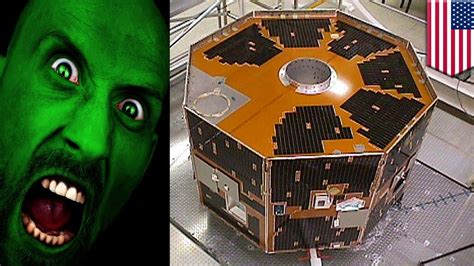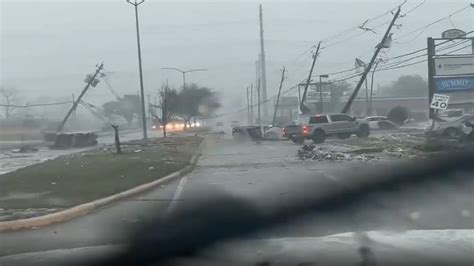
A large and destructive tornado ripped through North Dakota on Monday, causing widespread damage and prompting emergency responses across the affected regions.
A confirmed tornado touched down in North Dakota on Monday, leaving a trail of destruction and prompting urgent responses from emergency services. According to the National Weather Service (NWS), the large tornado struck areas in and around Watford City, McKenzie County, causing significant damage to infrastructure and property. The extent of injuries remains under assessment, but authorities are actively working to ensure the safety and well-being of residents.
Impact and Damage Assessment
The tornado’s impact was substantial, with reports indicating widespread damage to homes, businesses, and critical infrastructure. Preliminary assessments suggest that the areas surrounding Watford City bore the brunt of the storm, with fields, power lines, and buildings sustaining significant damage. “We are still in the early stages of assessing the full extent of the damage,” stated a spokesperson from the McKenzie County Emergency Management, “but it is clear that this was a significant weather event that will require a coordinated response.”
Photographs and videos circulating on social media depict scenes of devastation, with overturned vehicles, debris-strewn landscapes, and damaged structures. The visual evidence underscores the power and destructive force of the tornado.
Emergency Response and Relief Efforts
In the immediate aftermath of the tornado, emergency services were mobilized to provide assistance to affected residents. Search and rescue operations were initiated to ensure that all individuals were accounted for and to provide medical aid to those in need. Shelters were established to provide temporary housing for displaced residents, and efforts were underway to restore essential services, such as power and water.
North Dakota Governor Doug Burgum addressed the situation, pledging state resources to support the recovery efforts. “The state stands ready to provide any necessary assistance to the affected communities,” Burgum stated in a press release. “We are working closely with local officials to ensure that residents receive the support they need to rebuild their lives.”
The American Red Cross and other volunteer organizations have also deployed teams to North Dakota to provide assistance with shelter, food, and other essential services. Donations are being collected to support the relief efforts, and volunteers are being recruited to assist with cleanup and recovery operations.
Meteorological Context and Warnings
The tornado occurred amid a period of severe weather across the northern Plains, with forecasters issuing warnings for thunderstorms, high winds, and potential tornadoes. The NWS had issued a tornado watch for the affected region several hours before the tornado touched down, providing residents with advance notice of the potential threat.
“We urge residents to heed warnings from the National Weather Service and take appropriate precautions during severe weather events,” stated a meteorologist from the NWS. “Tornadoes can develop rapidly, and it is essential to have a plan in place to protect yourself and your family.”
The NWS is conducting a thorough analysis of the meteorological conditions that led to the development of the tornado, including radar data and atmospheric measurements. This analysis will help to improve forecasting accuracy and provide valuable insights for future severe weather events.
Community Resilience and Recovery
Despite the devastation caused by the tornado, there is a strong sense of community resilience and determination among residents. Neighbors are helping neighbors, and volunteers are working tirelessly to clear debris and provide support to those in need.
Local businesses and organizations are also stepping up to provide assistance, offering supplies, equipment, and financial support. The spirit of cooperation and solidarity is evident throughout the affected communities, demonstrating the strength and resilience of the human spirit in the face of adversity.
The recovery process will be long and challenging, but residents are committed to rebuilding their lives and restoring their communities. With the support of state and federal agencies, volunteer organizations, and the broader community, North Dakota will emerge stronger from this devastating event.
Historical Tornado Activity in North Dakota
While North Dakota is not typically associated with high tornado activity compared to states in “Tornado Alley,” it does experience tornadoes, particularly during the late spring and summer months. Historical records indicate that North Dakota averages approximately 25 tornadoes per year.
The most significant tornado outbreak in North Dakota history occurred on June 20, 1957, when a series of powerful tornadoes struck several communities, causing widespread damage and fatalities. More recently, a tornado in 2013 caused significant damage to the town of Killdeer. These events underscore the potential for severe weather in North Dakota and the importance of preparedness.
The Science of Tornadoes
Tornadoes are among the most violent and destructive weather phenomena on Earth. They are formed from severe thunderstorms, specifically supercell thunderstorms, which are characterized by a rotating updraft called a mesocyclone.
The formation process typically begins when warm, moist air collides with cold, dry air, creating instability in the atmosphere. If the conditions are right, the rising air can begin to rotate, forming a mesocyclone. As the mesocyclone intensifies, it can stretch vertically and narrow, increasing the speed of rotation.
When the rotating column of air descends from the cloud base and touches the ground, it becomes a tornado. Tornadoes are classified using the Enhanced Fujita (EF) Scale, which rates them based on the damage they cause. The scale ranges from EF0 (weak) to EF5 (violent), with EF5 tornadoes having winds exceeding 200 mph.
Preparing for Tornadoes
Given the potential for tornadoes in North Dakota, it is essential for residents to be prepared. The following are some tips for tornado preparedness:
- Stay Informed: Monitor weather forecasts and warnings from the National Weather Service. Sign up for weather alerts on your smartphone or radio.
- Develop a Plan: Create a family emergency plan that includes a designated safe room or shelter. Practice the plan regularly.
- Build a Kit: Assemble an emergency kit that includes food, water, medications, a flashlight, a radio, and other essential supplies.
- Know the Signs: Be aware of the signs of a tornado, such as a dark, greenish sky, large hail, a loud roar, or a visible funnel cloud.
- Seek Shelter: If a tornado warning is issued, seek shelter immediately. The safest place to be is in a basement, storm cellar, or interior room on the lowest floor of a sturdy building.
- Protect Yourself: If you are outdoors, lie flat in a ditch or other low-lying area and cover your head with your arms.
- After a Tornado: After the tornado has passed, check for injuries and damage. Be careful of downed power lines and other hazards. Report any damage to authorities.
Long-Term Recovery and Resilience
The recovery from a tornado can be a long and challenging process, requiring a coordinated effort from government agencies, volunteer organizations, and the affected communities. Long-term recovery efforts typically focus on rebuilding infrastructure, providing housing assistance, and addressing the emotional and psychological needs of residents.
Building resilience is also a key component of long-term recovery. This involves strengthening infrastructure to withstand future storms, improving emergency preparedness, and promoting community engagement. By learning from past events and investing in resilience, North Dakota can better protect its communities from the impacts of future tornadoes.
The recent tornado in North Dakota serves as a reminder of the power and unpredictability of nature. By staying informed, being prepared, and working together, residents can mitigate the risks and build stronger, more resilient communities.
Further details regarding the Tornado:
The recent tornado that struck North Dakota on Monday not only left a physical scar on the landscape but also triggered a chain of reactions, from immediate rescue operations to long-term recovery strategies. This event underscores the vulnerability of communities in the face of severe weather and the crucial need for comprehensive disaster preparedness.
Eyewitness Accounts
Eyewitness accounts paint a vivid picture of the tornado’s fury. Residents described seeing a massive, dark funnel approaching their homes, accompanied by a deafening roar. The speed and intensity of the storm left many feeling helpless as they sought shelter.
“It was like nothing I’ve ever seen,” said a resident of Watford City, who wished to remain anonymous. “The sky turned black, and then there was this huge cloud coming right at us. We barely had time to get to the basement before it hit.”
Another resident recounted the experience of watching their neighbor’s barn collapse under the force of the wind. “The whole thing just twisted and fell apart,” they said. “It was terrifying.”
These personal stories highlight the emotional toll that tornadoes can take on individuals and communities. The trauma of experiencing such a devastating event can have lasting effects, underscoring the importance of providing mental health support to affected residents.
Infrastructure Damage
The tornado caused significant damage to infrastructure, including power lines, roads, and bridges. Power outages were widespread, leaving thousands of residents without electricity. Transportation was also disrupted, with roads blocked by debris and downed power lines.
The damage to infrastructure will require a substantial investment in repairs and reconstruction. The cost of rebuilding roads, bridges, and power lines could run into the millions of dollars. The recovery process will also require careful planning to ensure that infrastructure is rebuilt to withstand future storms.
Agricultural Impact
North Dakota is a major agricultural state, and the tornado caused significant damage to crops and livestock. Farmers reported widespread losses of wheat, soybeans, and other crops. Livestock were also affected, with some animals injured or killed by the storm.
The agricultural impact of the tornado could have long-term economic consequences for the state. The loss of crops and livestock will reduce farm incomes and could lead to higher food prices. The recovery process will require assistance to farmers to help them replant their crops and rebuild their livestock herds.
Federal Assistance
In the wake of the tornado, North Dakota Governor Doug Burgum requested federal assistance to support the recovery efforts. The Federal Emergency Management Agency (FEMA) is assessing the damage and working with state and local officials to determine the extent of federal aid that will be needed.
Federal assistance could include funding for debris removal, infrastructure repairs, and housing assistance. FEMA also provides support for individuals and families who have been affected by the storm. The availability of federal assistance will be crucial to helping North Dakota recover from the tornado.
Role of Technology
Technology played a vital role in warning residents about the tornado and coordinating the emergency response. The National Weather Service used radar and other tools to track the storm and issue timely warnings. Social media platforms were used to share information and coordinate relief efforts.
Technology can also play a role in long-term recovery. Drones can be used to assess damage and identify areas that need the most assistance. Geographic information systems (GIS) can be used to map damage and track recovery progress.
Community Collaboration
The recovery from the tornado will require a collaborative effort from government agencies, volunteer organizations, and the affected communities. Local residents are already coming together to help their neighbors, clearing debris, providing food and shelter, and offering emotional support.
Volunteer organizations such as the American Red Cross and the Salvation Army are providing assistance with shelter, food, and other essential services. Government agencies are working to restore essential services and provide financial assistance to those in need.
The spirit of cooperation and collaboration is essential to ensuring a successful recovery. By working together, the people of North Dakota can overcome the challenges posed by the tornado and rebuild their communities.
Mental Health Support
The trauma of experiencing a tornado can have lasting effects on mental health. Many people who have been affected by the storm may experience anxiety, depression, or post-traumatic stress disorder (PTSD).
It is important to provide mental health support to those who have been affected by the tornado. Mental health professionals can provide counseling, therapy, and other services to help people cope with the emotional impact of the storm.
Mental health support should be readily available and accessible to all who need it. This includes providing services in schools, workplaces, and community centers. It is also important to raise awareness about mental health issues and reduce the stigma associated with seeking help.
Rebuilding Stronger
The recovery from the tornado provides an opportunity to rebuild stronger and more resilient communities. This includes strengthening infrastructure to withstand future storms, improving emergency preparedness, and promoting community engagement.
New building codes can be adopted to ensure that structures are better able to withstand high winds. Emergency plans can be updated to reflect the lessons learned from the tornado. Community outreach programs can be developed to educate residents about tornado preparedness and encourage them to participate in recovery efforts.
By learning from the past and investing in the future, North Dakota can build stronger and more resilient communities that are better able to withstand the impacts of severe weather.
The Economic Impact
The economic impact of the tornado extends beyond the immediate damage to homes, businesses, and infrastructure. The disruption to agriculture, transportation, and other sectors of the economy could have long-term consequences.
The state government is working to assess the economic impact of the tornado and develop strategies to mitigate the effects. This includes providing assistance to businesses that have been affected by the storm and promoting economic development in the affected communities.
The economic recovery will require a long-term commitment from the state government, the federal government, and the private sector. By working together, they can help North Dakota rebuild its economy and create new opportunities for its residents.
Lessons Learned
The tornado in North Dakota provides valuable lessons about disaster preparedness and response. These lessons can be used to improve emergency management practices and build more resilient communities.
One key lesson is the importance of early warning systems. The National Weather Service’s ability to track the storm and issue timely warnings saved lives. Another lesson is the importance of community collaboration. The outpouring of support from local residents, volunteer organizations, and government agencies demonstrated the power of working together.
By learning from the past and applying these lessons to the future, North Dakota can be better prepared for the next disaster.
Conclusion
The tornado that struck North Dakota on Monday was a devastating event that caused widespread damage and disruption. The recovery process will be long and challenging, but the people of North Dakota are resilient and determined.
By working together, they can overcome the challenges posed by the tornado and rebuild their communities. The recovery provides an opportunity to rebuild stronger and more resilient communities that are better prepared for future disasters. The commitment to recovery and resilience will not only heal the physical wounds but also strengthen the social fabric of these communities, ensuring a brighter and safer future for all.
Frequently Asked Questions (FAQ)
1. Where did the tornado hit in North Dakota and what areas were most affected?
The tornado primarily affected areas in and around Watford City, located in McKenzie County, North Dakota. Preliminary reports indicated significant damage to infrastructure and property in these areas.
2. What is the current status of emergency response efforts in the aftermath of the tornado?
Emergency response efforts are ongoing, focusing on search and rescue operations, providing medical aid to those in need, and establishing shelters for displaced residents. Authorities are working to restore essential services like power and water.
3. How can I help support the relief efforts for those affected by the tornado?
You can support relief efforts by donating to organizations like the American Red Cross or other local charities providing assistance. Additionally, volunteer opportunities may be available to help with cleanup and recovery operations. Contact local emergency management agencies for more information on how to volunteer.
4. What kind of weather warnings were issued before the tornado hit, and what precautions should I take during a tornado warning?
The National Weather Service (NWS) issued a tornado watch for the affected region several hours before the tornado touched down. During a tornado warning, seek shelter immediately in a basement, storm cellar, or interior room on the lowest floor of a sturdy building. If outdoors, lie flat in a ditch or low-lying area and cover your head with your arms.
5. What resources are available for residents who have experienced property damage or emotional distress due to the tornado?
Resources available include assistance from FEMA, the American Red Cross, and other volunteer organizations. These organizations provide support for housing, food, and other essential services. Mental health support services are also available to help individuals cope with the emotional impact of the storm. Contact local emergency management agencies or mental health organizations for assistance.

![Oreo’s [Flavor] So Good, Petition Time? Fans Demand Permanent Cookie!](https://duniateknoku.com/wp-content/uploads/2025/06/unnamed-file-864-150x150.jpg)







